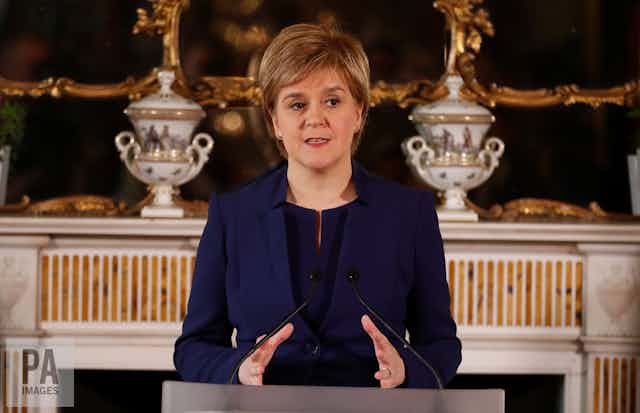A hung parliament: how little we appreciate the shape-shifting nature of politics in the UK. Like many people, I thought most analysis of the Scottish political landscape post-general election could be expressed before we fully knew the results, so I wrote the bulk of this piece early on, before reflecting on the way things actually played out.
The campaign was dominated by talk of “indyref2” – a second referendum on Scottish independence. As in the elections for Holyrood in 2016, the debate soon became polarised and simplistic. The SNP focused largely on Brexit and the UK Conservative government as symbols of the limited control of Scotland’s destiny held by Scottish voters.
The Conservatives went all out to use the election as a platform for its anti-referendum stance, even to the point of printing placards to protest the SNP’s manifesto launch. Both parties embraced “valence politics” wholeheartedly, focusing on each other’s lack of governing competence (the SNP in Scotland, the Conservatives in the UK), accentuating focus on the leaders, and simplifying their message to the extent that if there was any discussion of actual policies going on, they had failed.

The Conservatives found that this approach helped them regain ground in Scotland: they became obsessive in their declaration that the SNP is obsessed by the prospect of another referendum. There were other parties involved, but you could blink and miss their importance to this election.
The only way was down
The analysis will be dominated by a comparison with 2015, in which the SNP came close to winning all 59 seats (they managed 56, after securing just six in the previous election in 2010). Each seat lost by the SNP in 2017 will be interpreted by the Conservatives as a vote against a second independence referendum.
We faced the bizarre prospect of relatively few newly minted Conservative MPs declaring in their acceptance speeches to a far greater number of SNP MPs, that the people had spoken in the 2017 election: they don’t want another referendum. In fact, the longer-term story remains one of SNP dominance of almost every form of election in Scotland, to the point that opponents declare success if the SNP sees a drop in seats but still wins overall.
When viewed through the lens of the late 1990s when Labour dominated in Scotland, the SNP’s current position is truly remarkable. Perhaps the trick for most opposition parties is to portray the SNP’s 2017 results as a similar beginning of the end, with only another decade or so until it emulates Labour’s spectacular decline.
Yet, if we remain fixated on the constitution and neglect to debate properly the record of the Scottish (and UK) government, why would people vote for anyone except the SNP and, to a lesser extent, the Scottish Conservatives?
How it really played out
As it turned out, this analysis did not quite tell the whole story. The SNP did more than lose a few seats (21 in total, down to 35 from 56 seats in 2015). And even though they remain the largest party and won the election in Scotland, the result will, for some time, feel like a loss or at least a major setback, particularly since they experienced major losses with senior figures Alex Salmond and party deputy leader Angus Robertson.

With 13 seats (a huge increase of 12) that included the scalps of Salmond and Robertson, the Conservatives re-established themselves as Scotland’s main opposition, with every win providing disproportionate symbolic value and a chance to reiterate that their constituents are sick at the thought of another referendum.
Scottish Labour performed a minor miracle gaining seven seats (an increase of six), described before any serious analysis as evidence of a “Corbyn bounce”. Even the Liberal Democrats won back some credibility with four seats (an increase of three). So, in a shifting political landscape, the Scottish electorate helped rewrite a well-worn script.
We will need more reflection to work out the implications for a second referendum on Scottish independence. In the short term, it is clear that Nicola Sturgeon would not have announced one so quickly if she had her time again (although her hand was forced in part by the Brexit vote itself).
The phrase “now is not the time” seems to have more weight after the election, with or without Theresa May behind it. In the longer term, the further maintenance of SNP dominance in most elections will surely keep the issue high up the Scottish agenda, particularly when the implications of Brexit become clearer and start to bite.
But for now, it’s hard to believe that anyone has an appetite for any more voting on any issue.

